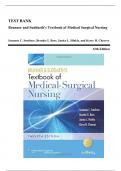Exam (elaborations)
Test Bank - Brunner and Suddarths Textbook of Medical Surgical Nursing, 12th Edition (Smeltzer, 2010), Chapter 1-72 | All Chapters
Test Bank - Brunner and Suddarths Textbook of Medical Surgical Nursing, 12th Edition (Smeltzer, 2010), Chapter 1-72 | All Chapters
[Show more]



